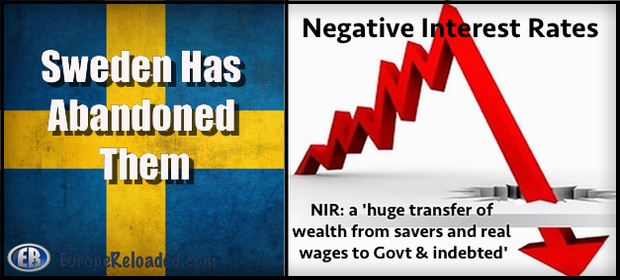
Why Sweden Ended Its Negative Interest Rate Experiment
Negative rates are the destruction of money, an economic aberration based on the mistakes of many central banks and some of their economists, who start with a wrong diagnosis: the idea that economic agents do not take more credit or invest more because they choose to save too much and that therefore saving must be penalized to stimulate the economy. Excuse the bluntness, but it is a ludicrous idea.
Inflation and growth are not low due to excess savings, but because of excess debt, perpetuating overcapacity with low rates and high liquidity, and zombifying the economy by subsidizing the low-productivity and highly indebted sectors and penalizing high productivity with rising and confiscatory taxation.
Historical evidence of negative rates shows that they do not help reduce debt, they incentivize it. They do not strengthen the credit capacity of families, because the prices of non-replicable assets (real estate, etc.) skyrocket because of monetary excess, and the lower cost of debt does not compensate for the greater risk.
Investment and credit growth are not subdued because economic agents are ignorant or saving too much, but because they don’t have amnesia. Families and businesses are more cautious in their investment and spending decisions, because they perceive, correctly, that the reality of the economy that they see each day does not correspond to the cost and the quantity of money.
It is completely incorrect to think that families and businesses are not investing or spending. They are only spending less than what central planners would want. However, that is not a mistake from the private sector side, but a typical case of central planners’ misguided estimates, which come from using 2001–7 as a “base case” of investment and credit demand instead of what those years really were: a bubble.
The argument of the central planners is based on an inconsistency — that rates are negative because markets demand them, not because they are imposed by the central bank. If that is the case, why not let rates float freely if the result is going to be the same? Because it is false.
Think for a moment what type of investment, company, or financial decision is one that is profitable with rates at –0.5 percent but unviable with rates at 1 percent. A time bomb. It is no surprise that investment in bubble-prone sectors is rising with negative rates and nonreplicable and financial assets skyrocketing.
Public debt trades at artificially low yields and, instead of strengthening economies, negative rates make governments more dependent on cheap debt. Politicians abandon any reformist impulse and prefer to accumulate more debt.
The financial repression of central banks begins with a misdiagnosis, assuming that low growth and below-target inflation is a problem of demand, not of the previous excess, and ends up perpetuating the bubbles that they sought to solve.
The policy of negative rates can only be defended by people who have never invested or created a job, because no one that has worked in the real economy can believe that financial repression will lead economic agents to take much more credit and strengthen the economy.
Negative rates are a huge transfer of wealth from savers and real wages to the government and the indebted. A tax on caution. They are the destruction of the perception of risk that always benefits the most reckless. The bailout of the inefficient.
Central banks ignore the effects of demography, technology, and competition on inflation and the growth of consumption, credit, and investment, and with the wrong policies they generate new bubbles that become more dangerous than the previous ones. The next bubble will again increase the fiscal imbalances of the countries. When central banks present themselves as the agents that will reverse the effect of technology and demographics, they will be creating a greater risk and bubble.
Sweden launched its failed negative rate plan almost five years ago and has now reversed it due to the financial risks that are created. The most interesting thing is that it reversed the policy of negative rates precisely because of the risk of an economic slowdown, because the evidence shows that investment and consumption decisions do not increase with financial repression.
In Sweden, with negative rates, the real estate price index has increased 50 percent (from 160 points to 240), the average residential index has risen 27 percent, non-replicable assets have risen between 30 and 70 percent (infrastructure, etc.), and the stock market has risen more than 20 percent. In that period, household consumption and investment (gross capital formation) have increased very little and real wages have remained stagnant.
Monetary policy has gone from being a support for structural reforms to an excuse to avoid them. Now, governments are delighted to read that “fiscal measures” must be implemented. And when a government hears “fiscal measures,” it translates it into “spending.” And when the eurozone governments start spending, the result is always the same: more debt and higher taxes.
In the eurozone, the economic aberration of negative rates continues despite the evidence of the collateral risks they generate. Meanwhile, you and I are blamed for not spending and borrowing more. What can go wrong?
************
Original article

••••
The Liberty Beacon Project is now expanding at a near exponential rate, and for this we are grateful and excited! But we must also be practical. For 7 years we have not asked for any donations, and have built this project with our own funds as we grew. We are now experiencing ever increasing growing pains due to the large number of websites and projects we represent. So we have just installed donation buttons on our websites and ask that you consider this when you visit them. Nothing is too small. We thank you for all your support and your considerations … (TLB)
••••
Comment Policy: As a privately owned web site, we reserve the right to remove comments that contain spam, advertising, vulgarity, threats of violence, racism, or personal/abusive attacks on other users. This also applies to trolling, the use of more than one alias, or just intentional mischief. Enforcement of this policy is at the discretion of this websites administrators. Repeat offenders may be blocked or permanently banned without prior warning.
••••
Disclaimer: TLB websites contain copyrighted material the use of which has not always been specifically authorized by the copyright owner. We are making such material available to our readers under the provisions of “fair use” in an effort to advance a better understanding of political, health, economic and social issues. The material on this site is distributed without profit to those who have expressed a prior interest in receiving it for research and educational purposes. If you wish to use copyrighted material for purposes other than “fair use” you must request permission from the copyright owner.
••••
Disclaimer: The information and opinions shared are for informational purposes only including, but not limited to, text, graphics, images and other material are not intended as medical advice or instruction. Nothing mentioned is intended to be a substitute for professional medical advice, diagnosis or treatment.





